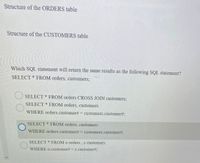
Database System Concepts
7th Edition
ISBN: 9780078022159
Author: Abraham Silberschatz Professor, Henry F. Korth, S. Sudarshan
Publisher: McGraw-Hill Education
expand_more
expand_more
format_list_bulleted
Concept explainers
Question

Transcribed Image Text:Structure of the ORDERS table
Structure of the CUSTOMERS table
Which SQL statement will return the same results as the following SQL statement?
SELECT * FROM orders, customers;
SELECT * FROM orders CROSS JOIN customers;
SELECT * FROM orders, customers
WHERE orders.customer#
customers.customer#;
SELECT * FROM orders, customers
WHERE orders.customer# > customers.customer#;
SELECT * FROM o orders , c customers
WHERE 0.customer# = c.customer#;
Expert Solution
This question has been solved!
Explore an expertly crafted, step-by-step solution for a thorough understanding of key concepts.
This is a popular solution
Trending nowThis is a popular solution!
Step by stepSolved in 2 steps with 2 images

Knowledge Booster
Learn more about
Need a deep-dive on the concept behind this application? Look no further. Learn more about this topic, computer-science and related others by exploring similar questions and additional content below.Similar questions
- Trying to write SQL statements for these shown here and having issues with them working. Explanation on this would be appreciated.arrow_forwardDatabase Q1: Select the correct SQL statement to provide the user Samer with read only permission on Employees table a) Grant read on Employee where username = Samer; b) Grant read only on Employee to Samer; c) Grant select to Samer on Employee; d) Grant select on Employee to Samer; Q2: Based on the TWO schema structures below, which SQL statement will create a view to show department names where each department has at least 5 employees? Employee (E_ID, E_Name, D_ID, E_Salary) Department (D_ID, D_Name, D_Address) (Select one) a) Create View Dept_Emp as select D_Name, count(E_ID) from Employee, Department where Employee D_ID = Department D_ID Group by D_Name Where count (E_ID) >= 5; b) Create View Dept_Emp as select D_Name, count(E_ID) from Employee D_ID = Department D_ID Group by D_Name Having count (E_ID) >= 5; c) Create View Dept_Emp as select D_Name, count(D_ID) from Employee, Department where Employee D_ID = Department D_ID Group by D_Name Having count (E_ID) >= 5; d)…arrow_forwardIs this statement true or false: Oracle SQL allows full expression-based use of both provided (built-in) and user-definable functions.arrow_forward
- Create a function to insert a new product into an existing order, include the product id, unit price, quantity. The output of the function is the message to notify the calling program whether the update succeeded or not. note : Note: Sql code need not java don't waste my time by giving java codearrow_forward5. Given two tables X and Y, which of the following relational algebra is false? X JOIN Y is not equal to Y JOIN X X DIFFERENCE Ý is not equal to Y DIFFERENCE X X RIGHT OUTER JOIN Y is equal to Y LEFT OUTER JOIN X X PRODUCT Y is equal to Y PRODUCT X a. b. с. d.arrow_forwardDatabase: https://www.w3schools.com/sql/trysql.asp?filename=trysql_select_allarrow_forward
- Database: https://www.w3schools.com/sql/trysql.asp?filename=trysql_select_allarrow_forwardI use the My SQL Workbench ,this question is for My SQL class ,can you provide me the solution using the My SQL workbench ?arrow_forwardWhich SQL statement lists the number of employees in each department? SELECT COUNT(EmployeeID), Department FROM Employees WHERE Department; SELECT COUNT(EmployeeID), Department FROM Employees GROUP BY Department; SELECT MAX(EmployeeID), Department FROM Employees GROUP BY Department; SELECT EmployeeID, Department FROM Employees WHERE COUNT (EmployeeID) GROUP BY Department;arrow_forward
- 31 Refer to the given SQL statement. SELECT PRODNUM, PRODNAME FROM PRODUCT: Which line designates a product number of at least 300 when added to the end of this statement? O WHERE PRODNUM>=300 WHERE PRODNUM=300+ O WHERE PRODNUM=(300; unlimited) WHERE PRODNUM=>300arrow_forwardHow can you dynamically execute a SQL query in PL/SQL? a. Using EXECUTE IMMEDIATE statement b. Using DBMS_SQL package c. Using FETCH statement d. Using OPEN-FOR statementarrow_forwardWrite an SQL statement that will insert an order in the orders table with the following data: cutomerID=3, orderDate = current date, shipAmount=20, taxAmount=23.56, shipDate=a week after current date, shipAddressID=3, cardType=2, cardNumber=4123123412341234, cardExpires=05/2024, billingAddressID=3 Write an SQL statement to delete all orders that are created between 2017-06-01 and 2017-06-07.arrow_forward
arrow_back_ios
arrow_forward_ios
Recommended textbooks for you
 Database System ConceptsComputer ScienceISBN:9780078022159Author:Abraham Silberschatz Professor, Henry F. Korth, S. SudarshanPublisher:McGraw-Hill Education
Database System ConceptsComputer ScienceISBN:9780078022159Author:Abraham Silberschatz Professor, Henry F. Korth, S. SudarshanPublisher:McGraw-Hill Education Starting Out with Python (4th Edition)Computer ScienceISBN:9780134444321Author:Tony GaddisPublisher:PEARSON
Starting Out with Python (4th Edition)Computer ScienceISBN:9780134444321Author:Tony GaddisPublisher:PEARSON Digital Fundamentals (11th Edition)Computer ScienceISBN:9780132737968Author:Thomas L. FloydPublisher:PEARSON
Digital Fundamentals (11th Edition)Computer ScienceISBN:9780132737968Author:Thomas L. FloydPublisher:PEARSON C How to Program (8th Edition)Computer ScienceISBN:9780133976892Author:Paul J. Deitel, Harvey DeitelPublisher:PEARSON
C How to Program (8th Edition)Computer ScienceISBN:9780133976892Author:Paul J. Deitel, Harvey DeitelPublisher:PEARSON Database Systems: Design, Implementation, & Manag...Computer ScienceISBN:9781337627900Author:Carlos Coronel, Steven MorrisPublisher:Cengage Learning
Database Systems: Design, Implementation, & Manag...Computer ScienceISBN:9781337627900Author:Carlos Coronel, Steven MorrisPublisher:Cengage Learning Programmable Logic ControllersComputer ScienceISBN:9780073373843Author:Frank D. PetruzellaPublisher:McGraw-Hill Education
Programmable Logic ControllersComputer ScienceISBN:9780073373843Author:Frank D. PetruzellaPublisher:McGraw-Hill Education

Database System Concepts
Computer Science
ISBN:9780078022159
Author:Abraham Silberschatz Professor, Henry F. Korth, S. Sudarshan
Publisher:McGraw-Hill Education

Starting Out with Python (4th Edition)
Computer Science
ISBN:9780134444321
Author:Tony Gaddis
Publisher:PEARSON

Digital Fundamentals (11th Edition)
Computer Science
ISBN:9780132737968
Author:Thomas L. Floyd
Publisher:PEARSON

C How to Program (8th Edition)
Computer Science
ISBN:9780133976892
Author:Paul J. Deitel, Harvey Deitel
Publisher:PEARSON

Database Systems: Design, Implementation, & Manag...
Computer Science
ISBN:9781337627900
Author:Carlos Coronel, Steven Morris
Publisher:Cengage Learning

Programmable Logic Controllers
Computer Science
ISBN:9780073373843
Author:Frank D. Petruzella
Publisher:McGraw-Hill Education